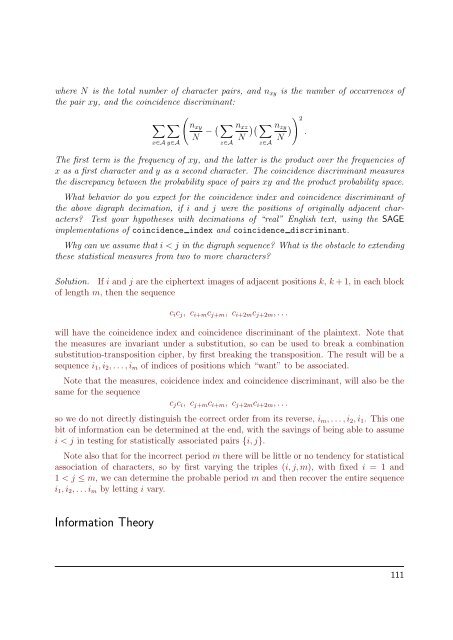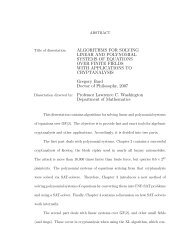Cryptography - Sage
Cryptography - Sage
Cryptography - Sage
Create successful ePaper yourself
Turn your PDF publications into a flip-book with our unique Google optimized e-Paper software.
where N is the total number of character pairs, and n xy is the number of occurrences ofthe pair xy, and the coincidence discriminant:∑ ∑x∈A y∈A(n xyN − ( ∑z∈An xz)( ∑Nz∈An zy) ) 2.NThe first term is the frequency of xy, and the latter is the product over the frequencies ofx as a first character and y as a second character. The coincidence discriminant measuresthe discrepancy between the probability space of pairs xy and the product probability space.What behavior do you expect for the coincidence index and coincidence discriminant ofthe above digraph decimation, if i and j were the positions of originally adjacent characters?Test your hypotheses with decimations of “real” English text, using the SAGEimplementations of coincidence index and coincidence discriminant.Why can we assume that i < j in the digraph sequence? What is the obstacle to extendingthese statistical measures from two to more characters?Solution. If i and j are the ciphertext images of adjacent positions k, k + 1, in each blockof length m, then the sequencec i c j , c i+m c j+m , c i+2m c j+2m , . . .will have the coincidence index and coincidence discriminant of the plaintext. Note thatthe measures are invariant under a substitution, so can be used to break a combinationsubstitution-transposition cipher, by first breaking the transposition. The result will be asequence i 1 , i 2 , . . . , i m of indices of positions which “want” to be associated.Note that the measures, coicidence index and coincidence discriminant, will also be thesame for the sequencec j c i , c j+m c i+m , c j+2m c i+2m , . . .so we do not directly distinguish the correct order from its reverse, i m , . . . , i 2 , i 1 . This onebit of information can be determined at the end, with the savings of being able to assumei < j in testing for statistically associated pairs {i, j}.Note also that for the incorrect period m there will be little or no tendency for statisticalassociation of characters, so by first varying the triples (i, j, m), with fixed i = 1 and1 < j ≤ m, we can determine the probable period m and then recover the entire sequencei 1 , i 2 , . . . i m by letting i vary.Information Theory111
















